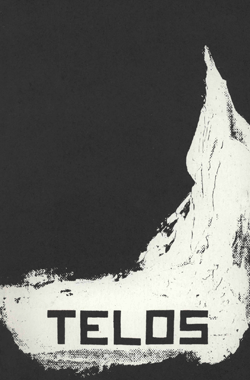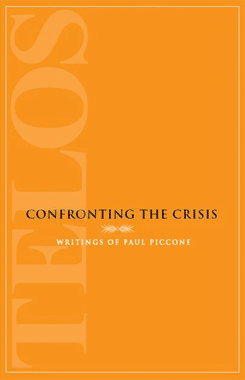As an occasional feature on TELOSscope, we highlight a past Telos article whose critical insights continue to illuminate our thinking and challenge our assumptions. Today, James Santucci looks at Paul Piccone’s “Towards a Socio-Historical Interpretation of the Scientific Revolution” in Telos 1 (Spring 1968). This essay was also republished as part of the anthology Confronting the Crisis: Writings of Paul Piccone, available from Telos Press.
Paul Piccone begins this essay with a word of caution for anyone looking back at the scientific revolution:
The scientific revolution of the 16th century is popularly thought of as having freed mankind from superstition and myth. This account, however, runs into difficulties when it is realized that superstition and myth are still with us and, furthermore, that institutionalized irrationality is a predominant feature of 20th century society.

The popularly held view that Piccone mentions doesn’t just arrive at different conclusions about what happened in history; it requires a completely different view of how history happens. History, in this view, has been continuously building toward modernity, and the triumph of rationalism and science in the sixteenth century were culture’s first steps toward the superior ways of being and thinking that we have today. The signal that our ways of being and thinking today are superior, of course, is that we have them today, and what could possibly be more modern?
To this progress- or evolution-oriented view and three alternative views, Piccone proposes an alternative, from Husserl. Husserl reconstructed the scientific revolution from a perspective of “reconstructing its historical roots, investigating its essential motives, and proposing concrete solutions.” What is involved in the scientific revolution in this view is not only the transformation of knowledge, but also the transformation of man from a creature who believes that the myths and superstitions worth holding are accessed through the church to one who believes that access to them is granted “through universal scientific reason to the norms of truth of all forms,” which transforms humanity “from the very root (Grund) into a new humanity capable of an absolute responsibility toward itself, following absolute theoretical judgment.”
The arena in which the old and new confronted each other was the choice between the Copernican cosmology and the Ptolemaic cosmology. We know, of course, that the Copernican cosmology won, that the earth orbits the sun, and that when one looks into space, one doesn’t see Heaven but instead sees more space. But how the Copernican system achieved victory demands some explanation.
The Ptolemaic view was accurate for most readings. If one can work past a collection of epicycles and “planets moving in all directions for no apparent reason,” it was adequate for most purposes. The lacuna was a difference of about a half-day between the actual year length and the length the view posited. This “quasi-trivial error” on the length of the year accumulated over centuries to displace the celebrations of saints from their proper locations in the calendar, which was unacceptable if anyone wanted to be a realist about saints.
Later, Copernicus, in an effort to simplify the bizarre epicyclic cosmology, invented a system that placed the sun in the center and introduced eight more epicycles, but ran into the cultural synthesis of the Scholastics. Since he was competing with a Ptolemaic view that held Heaven above the earth and a moral philosophy that emphasized growth toward nearness to God, his astronomic rearrangement was short-lived. Most importantly though, he had no answer to the question of why, if the earth was rotating so quickly, objects on its surface did not fly away into space.
Galileo faced many similar objections, but for some reason he was able to overcome them. Modern sensibilities would presume that he did so using experiments, which are of course the ultimate currency of scientific knowledge, but he did not. The second guess might be that he was able to explain some critical element that neither Copernicus nor the Ptolemaic theory could, but that also would not be true. Instead, as Piccone contends, even though Galileo’s physics and astronomy were “clearly empirically inferior to the traditional theories,” they were accepted.
This leads to the crux of Piccone’s argument. Unless there were some other reason to accept the new theories than their “scientific” merit, they would not have lasted. He writes:
Notwithstanding the empiricist propaganda regarding the superiority of the new physics due to its better correspondence with facts and observations, the debunking of Aristotelian physics and Ptolemaic astronomy came about in an altogether different manner than empiricist accounts lead one to believe. Furthermore, had the empiricist criteria been accepted at the time, the new science could not even have gotten started… Copernican astronomy was not any more based on scientific observations (hence, more empirical) than was the old Ptolemaic system; and even today, three centuries after the conclusive debunking of such a system as scientifically false, Ptolemaic astronomy is still successfully employed in local navigation . . .
Worse yet, the new physics would have met two very formidable objections: 1) not being able in any empirically verifiable way to show itself to be superior to the old theory, Galilean physics would have been shelved until it could show its worth; and 2) the new physics, in postulating non-observable entities such as one-body systems moving in frictionless pure space, was definitely not empirical. After all, who has ever seen a frictionless body?
But still, Galileo’s view survived.

What accounts for this isn’t any inherent value in the Galilean system—aside from, of course, its being almost “right.” Instead, Piccone attributes its success to its being a “paradigm of the concrete experiences of the concrete man—operating within the new and blossoming bourgeois social order.” While formerly, man existed in a world split between Heaven and earth, the Galilean physics and astronomy allowed him to believe only in a physical world. If Heaven existed—and it was still allowable that Heaven existed—it was elsewhere. Using his reason, concrete man could access all knowledge earth could provide. This epistemology appealed simultaneously to the Protestant work ethic and the Renaissance, which allowed Galilean astronomy and physics to overcome the empirical shortcomings it faced.
But here, Piccone’s warning returns. The Galilean victory was short-lived. Rather than Galileo’s revolutionary thinking, the mantle of science was claimed by traditionalists like Descartes who used particular methods to seek particular answers. Scientists who could think generally—as uomo universal would seem to imply—were gone. As a result, Piccone writes,
[T]he concrete man was fragmented into so many domains of “scientific” inquiry, thus reifying the creative subjectivity within the abstractions of the accepted categorical structures. In such a context no qualitative change is possible so it is not surprising to discover that, since the beginning of the 17th century, Western man has only perpetuated the essential reality of that period without either qualitatively altering or critically examining the conditions of his being. As a consequence, he finds himself presently threatened by self-annihilation, he still lives with scarcity in an economy of abundance, and his life is hounded by as much myth and superstition as any other period in his short stay on earth.
The series of abortive scientific revolutions Piccone describes should warn us. For revolution, it is not enough to learn one thing very deeply, nor is it enough to dabble in many subjects. What revolutionary thinking requires is a rejection of the idea of “subjects” in general—”this knowledge goes in this box”—and a pure seeking of knowledge unencumbered by traditional prejudices and superstitions. The bourgeois, who reaped the benefits of the scientific revolution concrete man wrought, installed and financed a social order that harnessed the free, revolutionary pursuit of Renaissance science and directed it to conservative ends. Fortunately, though, we can be anti-Bourgeois while maintaining Piccone’s final caveat: “This account does not entail an anti-scientific attitude, rather it presupposes a firm commitment to rationality as something more fundamental than science.”
Read the full version of Paul Piccone’s “Towards a Socio-Historical Interpretation of the Scientific Revolution” at the Telos Online website. If you are affiliated with an institution that is an online subscriber to Telos, you have free access to our complete online archive. If not, you can purchase 24-hour access to this and other Telos articles at a per-article rate. Follow the article link for more details.



